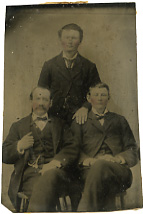Guest blogger: Megan
 I sometimes think of the tintype as the ugly duckling of nineteenth-century photo processes. Those that have made it intact to the twenty-first century are often battered, bent, or rusted, the image sometimes shot through with a fine constellation of scratches. Nevertheless, tintypes have a durability that outlasts most, if not all, other processes. It’s not uncommon to be sifting through a box of photographs only to find a tiny tintype portrait the size of your thumbnail loose in a crease somewhere, looking no worse for wear. Do that to an albumen photograph or a cyanotype, and it would have been crushed to powder long ago. That, in part, is the beauty of a tintype: you really, really have to work to damage one.
I sometimes think of the tintype as the ugly duckling of nineteenth-century photo processes. Those that have made it intact to the twenty-first century are often battered, bent, or rusted, the image sometimes shot through with a fine constellation of scratches. Nevertheless, tintypes have a durability that outlasts most, if not all, other processes. It’s not uncommon to be sifting through a box of photographs only to find a tiny tintype portrait the size of your thumbnail loose in a crease somewhere, looking no worse for wear. Do that to an albumen photograph or a cyanotype, and it would have been crushed to powder long ago. That, in part, is the beauty of a tintype: you really, really have to work to damage one.
Tintypes (less commonly known as a melainotypes or ferrotypes) came to prominence in the United States in 1859. In the late 1850s, the American photographic market was dominated by the daguerreotype and the ambrotype, both expensive photographic processes usually reserved only for those of means who could afford such a labor-intensive portrait of themselves or their families. Tintypes, on the other hand, ushered in an era of photography for the masses. First of all, they could be cheaply produced, being made very simply of a thin sheet of iron that was blackened with lacquer or enamel and then sensitized with a collodion emulsion. Secondly, tintypes could, in a sense, be mass-produced: a photographer, using a multi-lens camera, could capture one image multiple times on a sheet of iron and later cut that sheet into single photographs. Though some tintypes were placed in lavish wood, thermoplastic, or velvet cases, more likely they were left loose or slid into paper mats, easy enough to send in the mail to a relative or slip into a pocket without worrying that the photo would be broken or creased.
Tintype photographs are a direct positive process, meaning that no negative was created during the making of the photograph. Instead, they have laterally reversed images. In layman’s terms, this means that if your great-great-grandmother had a mole on her right cheek, a tintype of her would show that mole on her left cheek. So, in a sense, tintype photographs are mirror images of the people and places they depict. This can drive an historian to distraction, trying to remember that an ancestor’s 1860s predilection for wearing a monocle on his left eye appears in the visual record on the opposite eye or that a rare tintype of an outdoor scene that shows a stone wall to the right of an oak tree was really reversed in real life.
The craze for tintypes reached its peak during the Civil War, as Americans indulged in a new-found fascination with documenting and collecting specimens of their visual world. They were often hand-tinted, as is the tintype above of Juneau gold prospector Richard Tighe Harris and two unidentified young men – look at the rosy blush applied to their cheeks. Note also the uneven edges, where the photographer cut the image from the iron sheet with shears; this roughness of presentation is characteristic of tintypes.
In his landmark 1982 book, The History of Photography, art historian Beaumont Newhall wrote that tintypes were “usually casual; when the results have charm it is due to the lack of sophistication and to the naïve directness characteristic of folk art.” (Newhall 63) What a back-handed compliment. Tintypes were not meant to be “sophisticated” artwork. They were meant to be part of the historical record, an honest rendering of one’s self or loved ones at a particular moment in time. If they have a roughness to them, it’s due to this simple practicality, which does not detract from presentation of the subject. Tintypes were created to withstand the ravages of time, and in that they have succeeded.


